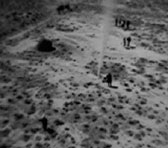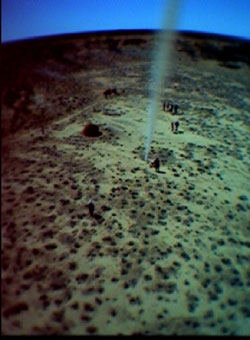17 October 2008
Team Music, Kite Music and Digger Music
Jon Rose reports on three new transmission projects (Sounds Outback, October 2008)
 Image: A view from the kite (for a larger image, see end of article)
Image: A view from the kite (for a larger image, see end of article) Wogarno Station is six hours from Perth on the Great Northern Highway – if you put your foot down. Our invitation was from Tos Mahoney for the Sounds Outback Festival; our mission was to realise three new interactive projects in as many days.
In recent months, with support from the Inter-Arts fund, Robin Fox, Jim Sosnin and I have been trying to solve the persistent problems faced by musicians implementing wireless data gathering technologies. This Transmission Project is developing technologies and approaches to real-time interactive performance in rugged, challenging, if not hostile, environments.
Having performed at 'Violins in the Outback' and bowed the fences of Wogarno, I knew we were about to be suitably challenged.
The nearest town to Wogarno is Mount Magnet, and they must feel like they exist in an alternative universe. In the middle of a state-wide mining boom, their local gold mine has closed down. This has reduced the population to about 450 quite depressed and confused folks.
The first project up is Team Music – an interactive netball game with accelerometers, sensors that measure the speed and movement, actually built inside the ball. There are precedents for this, going back to the interactive badminton game Perks (1996), but not tested was the G-force that the new generation of accelerometers could handle.
Alice Kavanagh runs the recreation centre at Mount Magnet, and without her help, no game would have been possible. Slowly some shy and non-vocal youth assemble. The age span is wide – probably from four to fourteen – and the teenagers are reluctant to play ball with the youngsters. Alice jumps in her car to muster some more from the town park. With a quick explanation, a few hand gestures, the teams are organised, rules are improvised, play is under way. The atmosphere is transformed. As the ball is thrown around, outback sounds are manipulated through the loudspeakers – flies, wind, sticks, stones – but the most convincing, connected and reactive appear to be the sounds sampled from an old unequal-tempered upright piano – the kind that may well have been in use in such a mining town hall until 30 years ago. A quick survey of some of the older Aboriginal kids demonstrates a small success: 'It was ace', 'Better than regular netball, definitely'. They came to play more the next day.
Pumped up with this experience, we are ready to dialogue with the elements. Back at Wogarno, a gusty wind obliges. The first attempt at Kite Music is quite short, as kite, electronics and mini-cameras are thrown casually by the wind into the nearest tree (not too many of them around here, but we found them, courtesy of Murphy’s law). There is a broken stay but the accelerometers survive. Second attempt rips half a nail off my finger. New music demands blood. Eventually, we are receiving serious video. There are three cameras, one pointing ahead, reading like a NASA space probe (when there are clouds to give a sense of distance); one camera points back towards the tail, taking audiovisual readings of swirling, disturbing intensity. The camera pointing down the kite line reveals a fish-eyed red ball being spun and vigorously shaken; human dots stumble around in the brightness. The Aeolian sound is all shake, rattle and roll. It can be experienced raw (as are the historic hummers used in Indonesian and Chinese large box kites), or used to drive digital media. This we did using the vagaries of wind power, to digitally drive a long sample of an eight-foot diapason organ pipe. The audiovisual data transmission dismisses all the standard new age delusions of the outback – here is a noisy and violent crucible.
Not many pieces of contemporary music call for a Kobelco Front End Hoe Excavator with a minimum 250-kilo loading in the score, but Digger Music did. Wogarno’s owner David Campbell knew a neighbour (about 150 kilometres away) who had just the ticket. It’s all favours in the outback. The awesome Ivan McLay drove the excavator, delivering on two separate evenings 20 minutes of challenging postmodern choreography. An accelerometer gaffer-taped to the hoe mapped and transmitted this data to Robin Fox, who fused the live and stored digger images and sound of video artist Gabi Iglesias with the irregular clunks, clonks, and purrs of the mechanical arm at work. More animal than machine, we all noted. Like a hand in the glove, the projections outlined the extremities of the shearing shed, as dusk turned to night. I played violin obligato.
Later around an open fire, members of the audience offered that they had imagined being back in a world of the brontosaurus. A number had a 250-kilo loading monster on their own farm. The audiovisual animation of such a commonplace piece of equipment was clearly acceptable behaviour in the outback, a large city environment would probably have rendered the activity as performance art. No one complained about the violin playing, either.

Further links
Jon Rose - AMC (http://www.amcoz.com.au/composers/composer.asp?id=143)
Jon Rose - personal homepage (www.jonroseweb.com)
Interspecies Music - a YouTube video (http://au.youtube.com/user/violinspeak)
Sounds Outback Festival (www.tura.com.au/events/regional/sounds_outback2008/)
© Australian Music Centre (2008) — Permission must be obtained from the AMC if you wish to reproduce this article either online or in print.
Subjects discussed by this article:
In January and February 2009, Jon Rose and Robin Fox will be artists in residence at The Performance Space, Sydney. A series of experiments will lead to the bicycle powered interactive sonic extravaganza PURSUIT on the 14th February.
Comments
Be the first to share add your thoughts and opinions in response to this article.
You must login to post a comment.